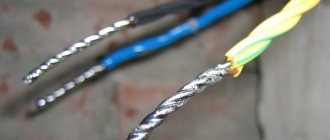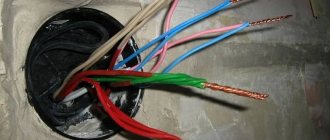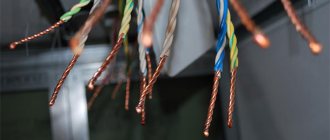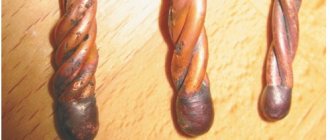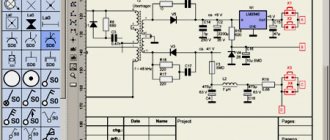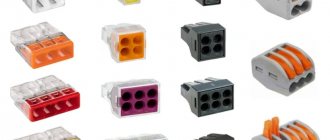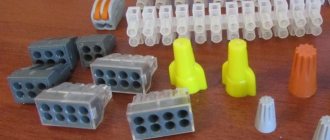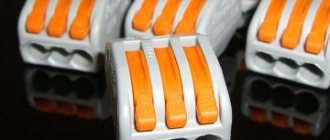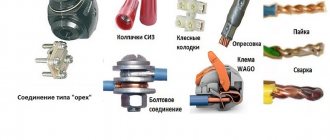How reliable are they?
Since the appearance of WAGO terminals on the market, there has been constant debate about whether they are good or not. Those masters who are against it say that the contact area is too small, over time the springs will become weaker, the contact will be even worse. The contact area is really small. But the WAGO connection terminal was invented in Germany, which has the strictest construction standards in Europe. Based on this, you can use these connectors according to the application.
WAGO feed-through terminals - quickly and reliably connect wires
Second point: these terminals are used for wiring all over the world, including the USA. Everyone knows how things are with the judicial system: they can sue for anything. If the products were of poor quality and unreliable, the company would have been sued a lot and would have gone bankrupt long ago. In general, speculative conclusions are unlikely to be taken into account. And practice shows that WAGO terminal blocks are convenient and reliable. You just need to follow the rules for their use.
There is only one point that needs to be monitored. Aluminum and copper oxidize, and as a result, the connection degrades, contact deteriorates, and it begins to heat up. We have not yet fully learned how to deal with this. Therefore, when using terminal blocks of any type, including WAGO, it is necessary to periodically inspect the connections. If you notice strong darkening, the connection needs to be updated. Then there will be no problems.
General points: how to work correctly with WAGO terminals
There is more than one video online showing burnt or melted WAGO connecting blocks. But there are thousands of other connections that have been in operation for years and nothing happens to them. It's all about following the rules, which simply cannot be ignored.
- The conductors must be stripped to the recommended length. No more, no less. This is not a whim, but a requirement based on precise technical calculations, testing and safety. The length of the exposed part of the conductor is designed so that the insulated wire enters the terminal block. This prevents electric shock when touched, and also protects the contact itself.
- Copper or aluminum wires should not be coated with oxides. Oxide films significantly impair electrical contact. Therefore, it is better to remove the insulation immediately before using the terminal block. As a last resort - if the wire is too short - the oxide film must be removed.
For ease of measurement, it is possible to connect tester probes
- When using WAGO self-clamping terminal blocks with paste (into which the wires are simply inserted), reuse of the block is not possible. Even if you just inserted the wires and then discovered that something was connected incorrectly. The wire can be pulled out, but the previously stripped part must be cut off and stripped again. And you need to use a new terminal block - along with the old wire, you removed some of the paste. Subsequent use of this pad does not guarantee proper contact.
- When connecting rigid wires of large cross-section, it is advisable to use plates to unload the bundle. This will ensure a stable position of the conductors and the contact will not become loose.
In general, these are all the basic rules. They are not that complicated. And one more thing: you should not use wires with a smaller cross-section than what the load requires. Yes, copper is expensive, but electrical is not where you should save money.
Installation of terminal blocks
To complete the installation, several recommendations should be followed. They are simple and, using them, it will be easy to understand any algorithms for connecting wires:
The cables should be kept in reserve for one more use. Junction boxes must be opened for inspection. The terminals are mounted in mounting boxes. The terminal block is purchased with a reserve in terms of current passed. The total load of the lines in the terminal block should not exceed the rated current. When the terminals are already installed, the device checking their voltage should be connected to the required sockets. Aluminum oxidation must be prevented by using a paste. When the wires are stripped, it is more convenient to check the marks on the terminal block
It is important to consider the permissible device parameters
The same cannot be said about reusable models. Here the cables are also stripped, then inserted into the sockets and clamped by lowering the orange flag. By lifting it, the cable can be pulled back out.
Advantages and disadvantages
The advantages of WAGO terminal blocks are speed of installation, clear and simple sequence of actions, and reliable connections. The connection time is minimal, and the result is predictable and stable. After all, the design is designed so that the impact of human error is minimal. The latest models are made using transparent plastic - this is an additional plus. At the installation stage, you can monitor whether the conductor is properly stripped and whether it is inserted all the way. During operation, the condition of the contact can be assessed through the transparent plastic. If the copper or aluminum is very dark or the contact area is blackened, it’s time to update the connection.
This is the 773 series - in a transparent plastic case
Vago terminal connectors also have disadvantages. The first is that copper and aluminum at the junction are oxidized, resulting in poor contact. Worse contact means more heating. The higher the temperature, the faster oxidation occurs. But this is also typical for screw terminal blocks. So this is not news at all. The advantage is that you can easily check the condition of the contact and, if necessary, reconnect it. In general, when using any type of terminal block, periodic inspection should be performed.
The second disadvantage is the price of Vago terminal blocks. Original products cost a lot, but you shouldn’t buy cheaper analogues. By the way, this is another disadvantage - a large number of fakes. Although they are very similar in appearance, their parameters are much worse, so it’s better not to take risks.
The video below explains how to distinguish original WAGO terminal blocks from Chinese counterfeits.
For connecting lamps
Connecting a chandelier or any other lamp yourself is not the most difficult thing. The most difficult thing is to figure out the wires that stick out from the ceiling or from the wall, but a multimeter can help here. If there are more horns than keys, you also need to group them. It's not too difficult either. But connecting wires under the ceiling is even more fun. Everything happens faster and easier using WAGO terminal blocks for connecting lamps. They are available in two series - 224 and 294. Series 224 is designed for connecting single wires, series 294 allows you to connect up to eight conductors.
The most convenient way to connect a chandelier is with Vago
Episode 224
The Wago 224 series connection terminal is designed specifically for connecting chandeliers, sconces, spotlights and other lighting devices. They may also be called “chandelier clamps” or something like that. A handy thing for quick and easy connection. Designed to operate in an alternating current network with a frequency of 50 Hz and a voltage of up to 400 V. Rated current when connecting wires with a diameter of 2.5 mm²:
- copper - 24 A,
- aluminum - 16 A.
This is what the Vago spring terminals for connecting a chandelier look like
WAGO 224 series terminal blocks are made on the basis of a flat-spring contact plate. That is, the contact of both wires occurs through one strip of metal, which clamps both conductors.
To connect the power cable, you only need to strip it to the specified length. The recommended length of the bare conductor is 10 mm. There is a mark on the body by which you can check how accurately you completed the task. After this, the wire is inserted into the appropriate socket. Clamping occurs automatically. The 224 series terminal clamps on the power cable connection side can be with or without paste. The paste removes oxides from the surface of the conductor, which ensures good contact. This is necessary if the wires have been stripped for a long time and they are too short to cut them and remove the insulation again.
Luminaire terminal blocks WAGO - 224 series
From the side of the lamp you can connect wires of any type: monocore, stranded hard or soft. On this side, to connect the wire, you need to press on the protruding part of the housing. A rectangular window will open, large enough in size so that you can easily insert a stranded wire. Insert the stripped (also 10 mm) wire all the way and release the “button”. The connection is ready.
What's good about WAGO 224 terminal clamps is that they can be used to connect copper and aluminum wires without any problems. They do not have direct contact, so there will be no electrolysis and destruction of the conductors.
Episode 294
This series is also positioned for connecting lighting equipment. These terminal clamps can also operate in an alternating current network with voltages up to 500 V. The maximum current when connecting 2.5 mm² copper wires is 24 A, the same aluminum wire is 16 A. It differs from the series described above in that all wires are connected to connectors mounted in one housing. Terminal blocks of the 294 series can have from two to seven inputs. There are options with a terminal for connecting grounding, and others without.
WAGO terminal clamp for connecting lighting equipment 294 series
All contact groups are signed, which will prevent confusion. On the side where the wires from the chandelier/sconce are connected there are holes through which you can use a probe to check the presence of voltage on the contact/wire. Terminals of the 294 series can be fixed to the wall using a self-tapping screw - for this purpose, the body has a special metal leg with a hole for a self-tapping screw. The second installation option is a special latch.
Inside there is a chromium-nickel (CrNi) spring that ensures proper contact. On the line side (wires are connected from the ceiling or from the wall) the clamp is self-clamping. On this side there is a spring, which can only be pressed out by a sufficiently rigid conductor. This is a mono-core or low-core rigid wire. The diameter of the conductors connected on this side is from 1 mm² to 2.5 mm² (small ones are recommended up to 2.0 mm²). Please note that this connection is not detachable. If desired, the wire can be pulled out, but it will need to be stripped again and a new terminal block used.
Using Vaga terminal blocks, connecting a chandelier is not a problem
You can connect any wires from a chandelier, sconce or other lighting fixture. Here, as in the 224 series, there is a spring-loaded button - a proprietary WINSTA
® Linect®. When you click on it, a window opens into which the conductor is inserted. The diameter of the wires on this side is from 0.75 to 2.5 mm². This connection is good because the wire can be easily removed - press the button and remove the conductor. The reconnection will be no worse in terms of parameters.
Terms of use
No matter how easy it is to install Vago cable terminal blocks, when working, you should take into account the features of the products and all the rules of electrical installation.
- A clamp is a standard and approved method of connecting wires. Therefore, using WAGO terminal blocks is in no way inferior to welding or soldering.
- Models with paste are designed to work with aluminum conductors - the composition protects the core from corrosion. For copper conductors, clamps without paste are required.
- For each electrical circuit, you need to select a cable of a suitable cross-section. And only according to this indicator choose the terminal block.
The terminal specifications must match the intended voltage and current.
For junction or junction boxes
Any wire connections must be serviceable. When wiring electrical connections, all connections are made in junction boxes. There are four Vago series for these purposes.
In junction boxes
WAGO 222 series terminal blocks
One of the most famous and popular series of Vago terminal clamps is 222. It is considered a universal clamp, as it can connect 2, 3 and 5 wires. Suitable for connecting solid and hard stranded wires with a cross-sectional area from 0.08 to 2.5 mm², with soft conductors the cross-section can be up to 4 mm². Like all others, it can be used for an alternating current network with a voltage of no higher than 400 V. Current loads - with a maximum cross-section of conductors of 2.5 mm² - 24 A (copper) with a cross-section of 4 mm² - 32 A.
Terminal clamp WAGO 222
A Vago spring clamp is used instead of twisting. You can use it to connect any devices and equipment. Connecting wires with the WAGO 222 is very simple. The contacts are equipped with flag latches. They go up and down easily. Thanks to this, you can easily assemble/reconstruct the network, disassemble existing connections for testing, measurements, etc. For convenient maintenance, there is a rectangular hole in the upper part of the case for a measuring instrument probe or an indicator screwdriver. Through it you can check the presence of voltage, determine whether it is phase or zero.
The WAGO 222 connecting terminal is designed for convenient connection of wires carrying significant current (up to 32 amperes)
To connect the conductors, we strip the insulation, exposing 8-10 mm of wire. Raise the flag, insert the conductor all the way, clamp the connection, lowering the flag into place. Please note that you need to lower the flag all the way, and this will require some effort. That's all - the connection is ready.
How to use WAGO 222
The WAGO 222 series connection terminal is suitable for connecting wires of different diameters or types: single-core to stranded. This is not very easy to achieve by other means. Only terminal blocks are suitable. There is also no conflict when connecting copper and aluminum, but for this purpose the contact cavity is filled with a special paste.
For fixing with horizontal wires
For installation in a control cabinet there is an adapter for mounting on a DIN rail. With its help, connectors can be screwed to any vertical or horizontal surface. For more accurate installation there is a harness relief plate.
It is better to secure the wires
Single-core or thin-core wires with a large cross-section do not bend well. To protect the connection from loosening the contact, they are secured using a relief plate. Its use is not necessary, but it increases reliability and the connection looks neater.
221 series - improved universal
Some time ago, a new series of Vago universal clamps was released - 221. It differs from the 222 series described above, which it replaced, in that it has smaller dimensions, a flatter body, and part of the front panel has become transparent. This is all for convenience. A smaller rectangular housing is easier to install in a distribution box, for example.
Universal compact terminals WAGO 221 series are more convenient than 222. The transparent housing of WAGO 221 allows visual inspection of installation
Transparent plastic allows you to control the quality of the connection - whether the wire is really stripped to the required length and whether it has not oxidized. The shape of the flag has also changed - it has become flatter and wider. Now it is more convenient to pry and easier to press.
These are the characteristics of the “standard version” - up to 4 mm2
A version has also appeared for thicker conductors - with a cross-section of up to 6 mm² (the codes are distinguished by the presence of a six in the second part: 221-612 or 221-613). They have a higher rated voltage - up to 450 V, rated current - up to 41 A. Other technical innovations include a higher operating temperature - up to +105°C.
WAGO's 221 series universal compact terminals allow you to quickly, easily and safely connect solid, stranded and fine-stranded conductors with cross-sections from 0.14 to 6 mm².
Self-clamping WAGO 773 and 2273 series - for permanent connections
For quick and easy connection of multiple wires, the WAGO 773 and 2273 series connection terminals are ideal. Externally, they differ little, but in technical parameters there is a significant difference:
The WAGO 773 series connection terminal is designed for larger wire cross-sections
- Conductor cross-section: 2273 - 0.5 mm - 2.5 mm²;
- 773 is available in two versions: 1.5-4 mm²;
- 2.5 - 6 mm².
- 2273 - 24 A;
Vago 2273 spring terminals are suitable for thin wires
So, the difference between the 773 and 2273 series is that 2273 is designed for thinner conductors - with a cross-section of no more than 2.5 mm². It is used when installing lighting networks - in distribution boxes. Vago 773 terminal blocks, on the contrary, work with more powerful wires that connect powerful consumers (such as a boiler, electric stove or oven). Therefore, these series cannot be confused.
WAGO connecting terminals of both series are designed to operate with voltages not exceeding 400 V. Due to the common spring, good contact of the connected conductors is ensured. This makes it possible to use 773 series terminals for installing a power network - a cross-section of up to 6 mm² - this is already serious and covers the needs of almost any private home.
Reliable contact is ensured by a flat-clamping spring
Connecting the wires is very simple. Stripped conductors (8-10 mm bare wires) are inserted into the sockets until they stop. All. You don't need to do anything else. The WAGO connection terminal securely holds and secures the wires. This connection method is convenient because you can easily connect wires of different diameters. For example, make a branch of a smaller diameter from a common highway.
In order to connect even just three wires with a cross-section of 6 mm² using twisting, you need to try hard. The wires are very stiff and it is almost impossible to achieve normal contact by twisting, but with WAGO connectors, even such thick wires have excellent contact.
Application of stranded wires
As I already said in the articles, stranded flexible wires are connected through Wago 222 terminals with a lever. However, flexible wires can also be connected through disposable 773. To do this, you need to use tips:
Flexible wire with lugs. The two tips on the right are not crimped
The tips are crimped using a special tool; pliers are not enough:
Tips for wires. Crimping in action
After this, you can use flexible wires on the same basis as rigid wires using one type of Wago clamp. For example, like in this photo:
Flexible wire into disposable Wago 773 through lugs
Another bonus is the tool and tips.
Crimping pliers, popularly known as crimping tips
Who doesn’t like IEK, you can use the branded one from Wago
Tips are sold in different sizes
They have different colors for convenience. May vary from manufacturer to manufacturer.
And they can be stored in this case
Service terminal
Connecting stranded wires is still a pleasure. It is difficult to achieve normal contact, since the wiring does not bend well. You can splice two wires using the WAGO service terminal (marking 224-201). It consists of two identical parts with buttons. When you click on them, a fairly large window opens into which the stripped conductor is inserted. When the button is released, the spring presses the wire against the pad.
Vago service terminal - for connecting multi-core wires
A similar operation is carried out on the other side. With this connection method, the contact plate has a large area of contact with the conductors - it clamps many wires. This really gives good results.
KVT contact paste
I would also not like to ignore the electrically conductive contact paste produced by KVT, and although it is positioned a little differently, the essence of its application remains the same.
The paste formulation is a mixture of metal filler with organic binders and includes mineral oil, thickeners and an electrically conductive composition. Contact paste is functional regardless of the type of current, frequency and voltage, and has high, time-stable electrical conductivity.
Contact conductive paste KVT
Operating temperature range from -40 to +100 degrees Celsius.
Applying contact paste to the metal surface provides long-term protection of the electrical contact from various physical and chemical processes occurring during operation.
The contact paste is seamlessly compatible with cable lugs and connectors produced by the KVT Electrical Plant and is guaranteed to provide a reliable electrical connection.
Contact paste is applied to the working surface of the electrical contact, while fine particles fill all the unevenness of the contact surfaces.
When the contact is tightened, the contact paste is compressed into a solid metal spacer, thereby increasing the working surface of the connection.
